Related Research Articles

Seyid Ali Imadaddin Nasimi, commonly known as simply Nasimi, was a 14th- and 15th-century Hurufi poet who composed poetry in his native Azerbaijani, as well as Persian and Arabic languages. He is regarded as one of the greatest Turkic poets of his time and one of the most prominent figures in Azerbaijani literature. Some sources also mention that he was born in Baghdad in 1339.
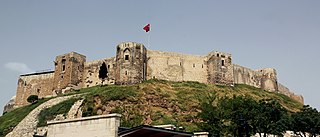
Gaziantep, historically Aintab and still informally calledAntep, is a major city in south-central Turkey. It is the capital of the Gaziantep Province, in the westernmost part of Turkey's Southeastern Anatolia Region and partially in the Mediterranean Region. It is located approximately 185 km (115 mi) east of Adana and 97 km (60 mi) north of Aleppo, Syria and situated on the Sajur River. The city is thought to be located on the site of ancient Antiochia ad Taurum and is near ancient Zeugma.
Sarkis Zeitlian was a Lebanese Armenian journalist and political leader of the Armenian Revolutionary Federation (ARF). He was abducted on 28 March 1985 in West Beirut, Lebanon and presumably murdered under unknown circumstances. At the time of his abduction, Zeitlian was director of the ARF's international media network. Zeitlian was a member of the Political Bureau of the Armenian Revolutionary Federation; the highest ranking subdivision of the Armenian Revolutionary Federation.

The Cathedral of Ani is the largest standing building in Ani, the capital city of medieval Bagratid Armenia, located in present-day eastern Turkey, on the border with modern Armenia. Its construction was completed in the early 11th century by the architect Trdat and it was the seat of the Catholicos, the head of the Armenian Apostolic Church, for nearly half a century.

Ani is a ruined medieval Armenian city now situated in Turkey's province of Kars, next to the closed border with Armenia.

The Masjid al-Nuqtah (Arabic: مَسْجِد النُّقْطَة, romanized: Masjid an-Nuqṭah, lit. 'Mosque of the Drop [of the Blood of Husayn]' is a mosque located on Mount Jawshan in Aleppo, Syria. The main feature of the mosque is a stone believed to be stained with the blood of Husayn ibn ‘Alī by Muslims.

Karen Vel Jeppe was a Danish missionary and social worker, known for her work with Ottoman Armenian refugees and survivors of the Armenian genocide, mainly widows and orphans, from 1903 until her death in Syria in 1935. She was a member of Johannes Lepsius' Deutsche Orient-Mission and assumed responsibility for the Armenian children in the Millet Khan German Refugee Orphanage after the 1895 Urfa massacres.

The Forty Martyrs Armenian Cathedral of Aleppo, Syria, is a 15th-century Armenian Apostolic church located in the old Christian quarter of Jdeydeh. It is significant among the Armenian churches for being one of the oldest active churches in the Armenian diaspora and the city of Aleppo. It is a three-nave basilica church with no dome. Its bell tower of 1912, is considered to be one of the unique samples of the baroque architecture in Aleppo.

Jisr Jindas, Arabic for "Jindas Bridge", also known as Baybars Bridge, was built in 1273 CE. It crosses a small wadi, known in Hebrew as the Ayalon River, on the old road leading south to Lod and Ramla. The bridge is named after the historic village of Jindas, which stood east of the bridge. It is the most famous of the several bridges erected by Sultan Baybars in Palestine, which include the Yibna and the Isdud bridges.
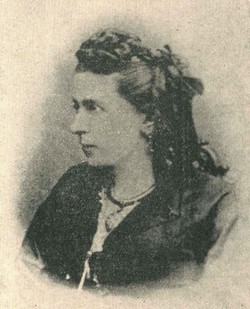
Maryana bint Fathallah bin Nasrallah Marrash, also known as Maryana al-Marrash or Maryana Marrash al-Halabiyah, was a Syrian writer and poet of the Nahda or the Arab Renaissance. She revived the tradition of literary salons in the Arab world and was the first Syrian woman to publish a collection of poetry. She may have been the first woman to write in the Arabic-language daily newspapers.
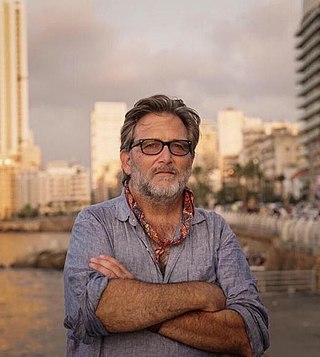
Keith David Watenpaugh is an American academic. He is Professor of Human Rights Studies at the University of California, Davis. A leading American historian of the contemporary Middle East, human rights, and modern humanitarianism, he is an expert on the Armenian genocide and its denial, and the role of the refugee in world history.
Riḍwān ibn Muṣṭafā ibn ʿAbd al-Muʿīn Pasha was a 16th-century Ottoman statesman. He served terms as governor of Gaza in the early 1560s and in 1570–1573, Yemen in 1564/65–1567, Habesh and Jeddah in 1573–1574 and Anatolia in 1582/83 until his death. During his term in Yemen, Ottoman authority largely collapsed. Ridwan Pasha was the progenitor of the Ridwan dynasty, which chose Gaza as its family headquarters, and where members of the dynasty ruled almost consecutively until 1690.

Gevherhan Sultan was an Ottoman princess, daughter of Sultan Ahmed I and Kösem Sultan, half-sister of Sultan Osman II, and sister of Sultans Murad IV (1623–1640) and Ibrahim of the Ottoman Empire.

Al-Jdayde is a historic predominantly Christian neighbourhood of Aleppo. It is noted for its winding narrow alleys, richly decorated mansions and churches. It was an area of significant cultural and historical interest. Much of Al-Jdayde suffered catastrophic damage during the Syrian Civil War.

"They Can Live in the Desert but Nowhere Else": A History of the Armenian Genocide is a book by Ronald Grigor Suny about the Armenian genocide, published by Princeton University Press in 2015. The book was praised as an accessible work that provides the academic consensus on why and how the Armenian genocide occurred.

The Waqf of Ibshir Mustafa Pasha is a sizeable 17th century endowment complex built by wazir Ipshir Mustafa Pasha in 1652 who was then governor of Aleppo. It has been described as of the largest and most interesting building complexes to be erected in Aleppo during Ottoman times.
The Armenian Massacres in Ottoman Turkey: A Disputed Genocide is a 2006 book by Guenter Lewy about the Armenian genocide in the Ottoman Empire. In the book, Lewy argues that the high death toll among Ottoman Armenians was a byproduct of the conditions of the marches and on sporadic attacks rather than a planned attempt to exterminate them.
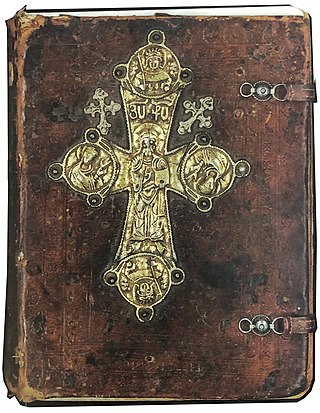
The Zeytun Gospels of 1256 AD is an Armenian illuminated manuscript in the Armenian language by artist and ordained priest T'oros Roslin. The Zeytun Gospels consists of four tabernacles, four evangelists, four namesakes, ornaments and decorations. The manuscript's patron was Catholicos Constantine I of Bardzrberd (1221–1267) and was commissioned for his godson Levon. It was transcribed in a scriptorium at the fortress Hromklay, "the God protected castle", in Cilician Armenia. Hromklay was also known as The School of Miniature Painting at the Catholicosate. The Hromklan scriptorium was at its peak while Roslin worked there on the Zeytun Gospels. The manuscript was later reintroduced as the Zeytun Gospels named after the mountain village of Zeytun during the late Ottoman Empire.
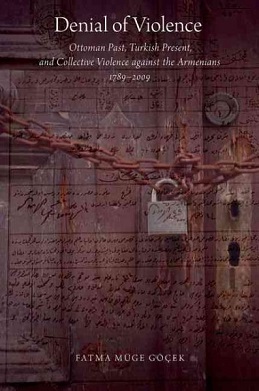
Denial of Violence: Ottoman Past, Turkish Present and Collective Violence Against the Armenians, 1789–2009 is a 2015 book by Turkish sociologist Fatma Müge Göçek which deals with the denial, justification, and rationalization of state-sponsored violence against Armenians in the Ottoman Empire and Turkey from the eighteenth to the twenty-first century, focusing especially on the Armenian genocide and its persistent denial in Turkey. Among the arguments made in the book is that the Armenian genocide was an act of foundational violence that enabled the creation of the Republic of Turkey and its continuing denial is an ideological foundation of the Turkish nation-state. The book was praised by reviewers for its extensive research and methodological innovation, although some noted that it was dense and not easy to read for those not familiar with the topic.
The brothers Petros (Petik) and Sanos were Armenian merchant magnates and Ottoman government tax-farmers from Old Julfa. They played a crucial role in the silk trade in Aleppo during the late 16th and first half of the 17th centuries, operating an extensive commercial network that reached the Dutch Republic and the Indian subcontinent and were important patrons of the Armenian community.
References
- ↑ "Heghnar Watenpaugh". Art History. June 28, 2013. Retrieved October 10, 2024.
- 1 2 3 4 5 Nikos-Rose, Karen (April 12, 2019). "Art Historian Finds Missing Pages of Armenian History". UC Davis. Retrieved May 20, 2023.
- ↑ "Heghnar Watenpaugh". Huffington Post. Retrieved May 22, 2023.
- 1 2 "The walls of injustice must crumble from within". Horizon Weekly . Armenian Revolutionary Federation. May 4, 2015. Retrieved May 20, 2023.
- 1 2 3 "2014 Election of Officers and Members of the Board". Middle East Studies Association of North America. Retrieved May 21, 2023.
- 1 2 "Heghnar Watenpaugh, Ph.D." UCDavis Cultural Studies. August 17, 2017. Retrieved May 21, 2023.
- ↑ The J. Paul Getty Trust 2004–2005 Report (PDF) (Report). J. Paul Getty Trust. p. 75.
- ↑ Watenpaugh, Heghnar (2004). The Image of an Ottoman City: Imperial Architecture and Urban Experience in Aleppo in the 16th and 17th Centuries. Brill. ISBN 978-90-474-0422-4 . Retrieved May 20, 2023.
- ↑ "Kostof Book Award Recipients". Society of Architectural Historians . Retrieved May 21, 2023.
- ↑ "Prizes & Awards". Syrian Studies Association. Archived from the original on April 7, 2017. Retrieved May 21, 2023.
- ↑ Watenpaugh, Heghnar Zeitlian (2019). "The Missing Pages: The Modern Life of a Medieval Manuscript, from Genocide to Justice". Stanford University Press. Retrieved May 20, 2023.
- ↑ "Berberian's and Zeitlian Watenpaugh's Books Chosen as Der Mugrdechian SAS Outstanding Book Award Recipients". Society For Armenian Studies. Retrieved May 21, 2023.
- ↑ "Announcing the Results of the 2020 Independent Publisher Book Awards". Independent Publisher. Retrieved May 21, 2023.
- ↑ "Recent Winners (2017-2022)". Ottoman & Turkish Studies Association. Retrieved May 21, 2023.
- ↑ "2020 Saroyan Prize Shortlist". Stanford Libraries (Press release). Retrieved May 21, 2023.
- ↑ "Heghnar Zeitlian Watenpaugh". John Simon Guggenheim Memorial Foundation... Retrieved May 20, 2023.
- ↑ "National Endowment for the Humanities Grant Awards and Offers, July 2020" (PDF) (Press release). National Endowment for the Humanities. 2020. p. 5. Retrieved May 20, 2023.
- ↑ Day, Jeffrey (February 28, 2022). "UC Davis Alumnus Brings Attention to Armenian Genocide With Lecture Series". UC Davis College of Letters and Science. Retrieved May 20, 2023.
- ↑ Reviews of The Image of an Ottoman City:
- Bozarslan, Hamit (2006). "Review of 'The Image of an Ottoman City. Imperial Architecture and Urban Experience in Aleppo in the 16th and 17th Centuries'". Studia Islamica (102/103): 236–239. ISSN 0585-5292. JSTOR 20141096.
- Elsheshtawy, Yasser (December 1, 2007). "Review: The Image of an Ottoman City: Imperial Architecture and Urban Experience in Aleppo in the 16th and 17th Centuries , by Heghnar Watenpaugh and Planning Middle Eastern Cities: An Urban Kaleidoscope in a Globalizing World". Journal of the Society of Architectural Historians. 66 (4): 532–535. doi:10.1525/jsah.2007.66.4.532. ISSN 0037-9808.
- Farhat, May. "Farhat on Watenpaugh, 'The Image of an Ottoman City: Imperial Architecture and Urban Experience in Aleppo in the 16th and 17th Centuries'". H-Levant. Retrieved May 20, 2023.
- Mikhail, Alan (2006). "Review of 'The Image of an Ottoman City: Imperial Architecture and Urban Experience in Aleppo in the 16th and 17th Centuries'". The Arab Studies Journal. 14 (2): 145–148. ISSN 1083-4753. JSTOR 27933982.
- O'Meara, Simon (2006). "Review of The Image of an Ottoman City: Imperial Architecture and Urban Experience in Aleppo in the 16th and 17th Centuries". British Journal of Middle Eastern Studies. 33 (2): 247–249. ISSN 1353-0194. JSTOR 20455469.
- Sajdi, Dana (2008). "Heghnar Zeitlian Watenpaugh, The Image of an Ottoman City: Imperial Architecture and Urban Experience in Aleppo in the 16th and 17th Centuries (Leiden/Boston: E. J. Brill, 2004). Pp. 326. $164.00 cloth". International Journal of Middle East Studies. 40 (1): 141–142. doi:10.1017/S0020743807080178. ISSN 0020-7438. S2CID 163130975.
- Singer, Amy (2009). "The image of an Ottoman city: imperial architecture and urban experience in Aleppo in the 16th and 17th centuries". Mediterranean Historical Review. 24 (1): 52–54. doi:10.1080/09518960903036623. ISSN 0951-8967. S2CID 162613419.
- ↑ Reviews of The Missing Pages:
- "Best of 2019: Our Top 25 Books". Hyperallergic. December 13, 2019. Retrieved May 21, 2023.
- Makhdoumian, Helen (2021). "Review of The Missing Pages: The Modern Life of a Medieval Manuscript, from Genocide to Justice". Rocky Mountain Review. 75 (1): 138–140. ISSN 1948-2825. JSTOR 27086135.
- Mulder, Stephennie (November 5, 2019). "Stephennie Mulder. Review of 'The Missing Pages: The Modern Life of a Medieval Manuscript, from Genocide to Justice' by Heghnar Zeitlian Watenpaugh". caa.reviews . doi: 10.3202/caa.reviews.2019.123 . ISSN 1543-950X . Retrieved May 20, 2023.
- Semerdjian, Elyse. "Elyse Semerdjian reviews The Missing Pages". Critical Inquiry. Retrieved May 20, 2023.
- Siekierski, Konrad (December 1, 2019). "Review: The Missing Pages: The Modern Life of a Medieval Manuscript, From Genocide to Justice, by Heghnar Zeitlian Watenpaugh". Journal of Medieval Worlds. 1 (4): 65–67. doi: 10.1525/jmw.2019.1.4.65 . ISSN 2574-3988.